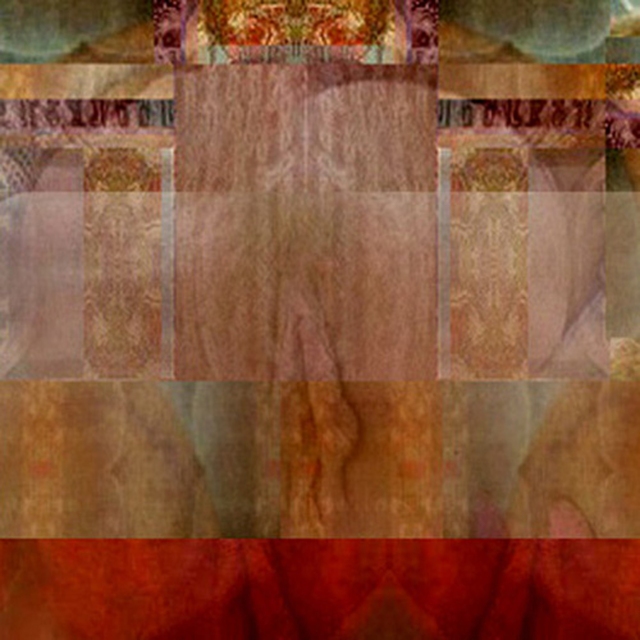
the birth Of the viractual (2002) 70×70” computer-robotic assisted acrylic on canvas painting by Joseph Nechvatal
Viractualism
The concept of viractuality (and hence viractualism) emerged in 1999 out of the research the artist and art theoretician Joseph Nechvatal conducted for his thesis Immersive Ideals / Critical Distances : A Study of the Affinity Between Artistic Ideologies Based in Virtual Reality and Previous Immersive Idioms written to earn his Ph.D. in the Philosophy of Art at the Centre for Advanced Inquiry in the Interactive Arts (CAiiA-STAR), University of Wales, Newport, Wales, U.K.. The concept of viractuality began with Nechvatal’s realization that every new technology disrupts previous habits of human art and consciousness.
The basis of the viractual conception is that virtual producing computer technology has led to the merging of the computed (the virtual) with the uncomputed corporeal (the actual). This merger—which tends to contradict techno clichés—is what Nechvatal called the viractual. According to Dr. Nechvatal, the blending of computational virtual space with ordinary viewable space indicates the topological cognitive-vision of connectivity today as it considers both the computed virtual and the uncomputed corporeal analog world in connective terms. The viractual recognizes and uses the power of digitization while being culturally aware of the values of monumentality and permanency: qualities which can be found in the history of powerful, long lasting, analog art. For Nechvatal, the viractual is a significant art concept that both motivates and explains his preference for creating digital artificial life animations that inform his computer-robotic assisted paintings on canvas; a painting technique based in conceptual art that Nechvatal has employed since 1986.
Gilles Deleuze’s consideration of Baruch Spinoza—the 17th century philosopher who merged mind and matter into one substance—in Deleuze’s book Spinoza: Practical Philosophywas a key influence on Nechvatal in the way he came to understand (in 1999) that the viractual indicates and initiates communions of the protoplasmic hard body with the softness of virtual spatial conditions. Also of influential interest to Nechvatal’s development of viractualism, was the classical hermaphroditic pansexual image. The importance of this hybrid-human image first came to Nechvatal in 1986 during the making of his stop-action puppet video animation ExStasis Ovid that contained the actress Jane Smith dramatically reading a section of Ovid’s epic poem Metamorphoses. In ExStasis Ovid, Smith’s reading of the text waifs in and out of comprehension through Nechvatal’s transformative synthesizer manipulations within fields of noise music.
The hermaphrodite initially occurs in Western culture as a son of Hermes and Aphrodite named Hermaphroditus. Hermaphroditus was a typical, if exceptionally handsome, young male with whom the water nymph Salmacis fell madly in love. When Hermaphroditus rejected her sexual advances, Salmacis desired him even more. One spring day Hermaphroditus stripped nude and dove into the pool of water which was Salmacis’s habitat. Salmacis immediately dove in after him, embracing him and wrapping her body around his, just as Ovid says, like ivy around a tree. She then prayed to the gods that she would never be separated from him and this prayer they answered favorably. Consequently, Hermaphroditus emerged from the pool both man and woman.
The patriarchal construction of woman as other and the female body as object is deeply rooted in the supposed duality (opposites) of the (two) sexes. Most feminist theory questions this patriarchal construction of sex and gender, suggesting that sex is expressed through a continuum, rather than as an opposing couplet based on heterosexist male/female polarities. Gender, within viractual understanding, is viewed as an act of becoming. Consequently, viractual gender performance fails to sustain sex oppression by ceasing to draw the boundaries of the Other. As such, the viractual conception is a provocation not only to male/female constructions of heterosexuality, but also to homosexual constructions of identity. For within viractuality, all signs are subject to boundless semiosis, which is to say that they are translatable into other signs. Thus it is possible to find resonances and affinities between opposites within viractualism, built out of the virtual abyss.
The viractual is a sensibility respectful of the integration of certain aspects of science, technology, myth, and consciousness in which everything, everywhere, all at once, is connected in a rhizomatic web of communication. Therefore, the viractual opposes the regurgitation of a standardized repertoire of image tropes. Rather, within viractualism is detectable a fertile attraction towards the abstractions of advanced scientific discovery, now stripped of its fundamentally reductive logical methodology. Such a viractual span of liminality is reminiscent of two very different, yet complementary, concepts: entrainment and égréore. Entrainment, in electro-physics, is the coupling of two or more oscillators as they lock into a commonly sensed interacting frequency. In alchemical terms, an égréore (an old form of the word agréger) is a third concept (or phenomenon) which is established from conjoining two different elements together. Nechvatal’s conception of viractualism suggests that the term the viractual (and viractuality) may be a concordant entrainment/égréore conception helpful in defining our now third-fused inter-spatiality which has been forged from the meeting of the virtual and the actual.
